AXY2S Module Datasheet
Last Updated on : 2024-06-14 09:31:19download
AXY2S is a low-power-consumption embedded Wi-Fi 6+Bluetooth module that Tuya has developed. Embedded with the Wi-Fi network protocol stack and rich library functions, it consists of a highly integrated wireless RF chip (ECR6600-TS2D).
Product overview
With a maximum clock rate of 240 MHz, AXY2S also contains a low-power-consumption Andes D10 MCU, a WLAN MAC, a 1T1R WLAN, a 512-KB SRAM, a 2-MB flash memory, and extensive peripherals.
AXY2S is an RTOS platform that integrates all function libraries of the Wi-Fi MAC and TCP/IP. You can develop embedded Wi-Fi products as required.
Features
- Embedded with a low-power-consumption Andes D10 MCU, which can also function as an application processor
Main clock rate: 240 MHz - Operating voltage: 3.0 to 3.6 V
- Peripherals: 5 GPIOs, 1 Data UART, 1 Log UART, and 1 ADC
- Wi-Fi and Bluetooth connectivity:
- 802.11 B/G/N20/N40/N40/AX20
- Channels 1 to 14@2.4 GHz (CH1 to 11 for US/CA and CH1 to 13 for EU/CN)
- Support WEP, WPA, WPA2, and WPA2 PSK (AES) security modes
- Support Bluetooth Low Energy 5.1
- Up to +20 dBm output power in 802.11b mode
- Support uplink/downlink MU-OFDMA
- Support fast network configuration via Wi-Fi for Android and iOS devices
- Onboard PCB antenna
- Certified by CE and FCC
- Operating temperature: -40℃ to 85℃
Applications
- Intelligent buildings
- Smart household and home appliances
- Smart socket and light
- Industrial wireless control
- Baby monitor
- Network camera
- Intelligent bus
Module interfaces
Dimensions and footprint
AXY2S has 2 lines of pins with a spacing of 2mm.
The AXY2S dimensions are 15±0.35 mm (W)×17.91±0.35 mm (L) ×2.9±0.15 mm (H). The dimensions of AXY2S are as follows:
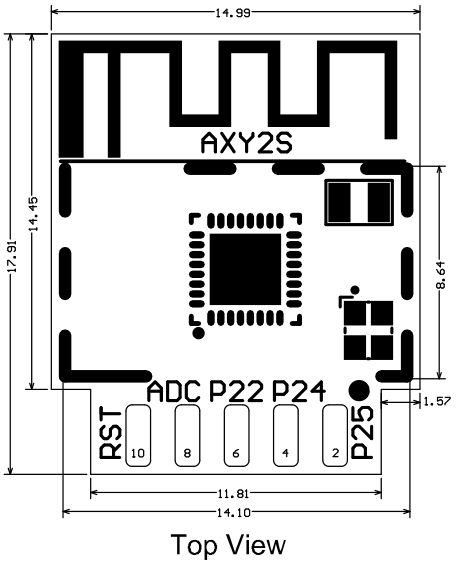
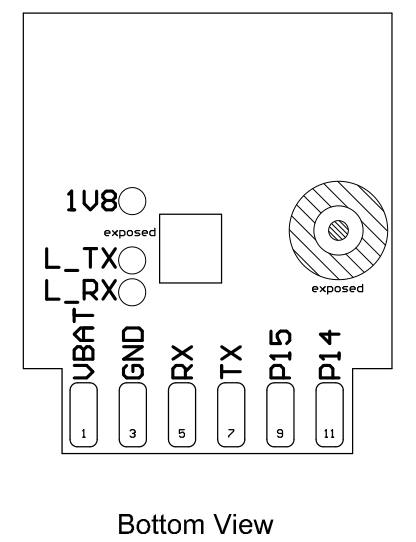
Pin definition
| Pin number | Symbol | Type | Function |
|---|---|---|---|
| 1 | VBAT | P | Power supply pin (3.3V) |
| 2 | P25 | I/O | GPIO_25, hardware PWM, correspond to Pin 7 of the IC |
| 3 | GND | P | Power supply reference ground |
| 4 | P24 | I/O | GPIO_24, hardware PWM, correspond to Pin 8 of the IC |
| 5 | RX | I/O | GPIO_5, UART0_RXD (user serial interface) |
| 6 | P22 | I/O | GPIO_22, hardware PWM, Pin 4 of the IC |
| 7 | TX | I/O | GPIO_6, UART0_TXD (user serial interface) |
| 8 | ADC | AI | GPIO_20, common GPIO, which can be used as ADC. The range of input voltage is 0 to 3.3V. Correspond to Pin 27 of the IC. |
| 9 | P15 | I/O | GPIO_15, hardware PWM, Pin 28 of the IC |
| 10 | RST | I/O | Reset pin, reset at a low level. The module has been pulled to a high level and the user can control the pin externally. |
| 11 | P14 | I/O | GPIO_14, hardware PWM, correspond to Pin 29 of the IC |
Note: P indicates a power supply pin and I/O indicates an input/output pin.
Electrical parameters
Absolute electrical parameters
| Parameter | Description | Minimum value | Maximum value | Unit |
|---|---|---|---|---|
| Ts | Storage temperature | -40 | 125 | ℃ |
| VDD | Power supply voltage | -0.3 | 3.6 | V |
| ESD voltage (human body model) | TAMB-25℃ | - | 2 | KV |
| ESD voltage (machine model) | TAMB-25℃ | - | 0.5 | KV |
Working conditions
| Parameter | Description | Minimum value | Typical value | Maximum value | Unit |
|---|---|---|---|---|---|
| Ta | Operating temperature | -40 | - | 85 | ℃ |
| VDD | Operating voltage | 3.0 | - | 3.6 | V |
| VIL | Voltage input low | 0 | - | 0.3vdd | V |
| VIH | Voltage input high | 0.7vdd | - | vdd | V |
| VOL | Voltage output low | - | - | 0.1vdd | V |
| VOH | Voltage output high | 0.9vdd | - | - | V |
| Imax | Drive current | - | 4 | - | mA |
| Cpad | Input pin capacitance | - | 2 | - | pF |
RF power consumption
TX power consumption:
| Symbol | Mode | Power | Average value | Peak value (Typical value) | Unit |
|---|---|---|---|---|---|
| IRF | 11b 1Mbps | 17dBm | 308 | 310 | mA |
| IRF | 11b 11Mbps | 17dBm | 304 | 305 | mA |
| IRF | 11g 6Mbps | 17dBm | 214 | 215 | mA |
| IRF | 11g 54Mbps | 15dBm | 175 | 176 | mA |
| IRF | 11n HT20 MCS0 | 17dBm | 217 | 218 | mA |
| IRF | 11n HT20 MCS7 | 14dBm | 179 | 180 | mA |
| IRF | 11n HT40 MCS0 | 15dBm | 191 | 192 | mA |
| IRF | 11n HT40 MCS7 | 13dBm | 169 | 170 | mA |
| IRF | 11ax HE20 MCS0 | 17dBm | 213 | 214 | mA |
| IRF | 11ax HE20 MCS7 | 14dBm | 179 | 180 | mA |
RX power consumption:
| Symbol | Mode | Average value | Peak value (Typical value) | Unit |
|---|---|---|---|---|
| IRF | 11B 1M | 32 | 32 | mA |
| IRF | 11B 11M | 32 | 32 | mA |
| IRF | 11G 6M | 33 | 33 | mA |
| IRF | 11G 54M | 34 | 34 | mA |
| IRF | 11N HT20 MCS0 | 33 | 33 | mA |
| IRF | 11N HT20 MCS7 | 34 | 34 | mA |
| IRF | 11N HT40 MCS0 | 37 | 37 | mA |
| IRF | 11N HT40 MCS7 | 38 | 38 | mA |
| IRF | 11AX HE20 MCS0 | 32 | 32 | mA |
| IRF | 11AX HE20 MCS7 | 32 | 32 | mA |
Power consumption during working
| Working mode | Working status, TA = 25°C | Average value | Peak value (Typical value) | Unit |
|---|---|---|---|---|
| Fast network configuration (AP) | The module is in fast network configuration state and the Wi-Fi indicator flashes slowly | 40 | 210 | mA |
| Fast network configuration (EZ) | The module is in fast network configuration state and the Wi-Fi indicator flashes fast | 40 | 197 | mA |
| Fast network configuration (Bluetooth) | The module is in fast network configuration state and the Wi-Fi indicator flashes fast | 41 | 184 | mA |
| No operation during network connection | The module is connected to the network and the Wi-Fi indicator is always on | 34 | 52 | mA |
| Operations are being performed during network connection | The module is connected to the network and the Wi-Fi indicator is always on | 36 | 61 | mA |
| Disconnected state | The module is disconnected and the Wi-Fi indicator is off | 35 | 51 | mA |
| The router is not powered | The module is disconnected and the Wi-Fi indicator is off | 34 | 84 | mA |
RF parameters
Basic RF features
| Parameter | Description |
|---|---|
| Frequency range | 2.400 to 2.4835 GHz |
| Wi-Fi standard | IEEE 802.11b/g/n/ax (channels 1 to 14) |
| Bluetooth standard | Bluetooth 5.1 |
| Data transmission rate | 11b: 1, 2, 5.5, and 11 (Mbps) |
| Data transmission rate | 11g: 6, 9, 12, 18, 24, 36, 48, 54 (Mbps) |
| Data transmission rate | 11n: HT20 MCS0 to 7 |
| Data transmission rate | 11n: HT40 MCS0 to 7 |
| Data transmission rate | 11ax: HE20 MCS0 to 7 |
| Antenna type | PCB antenna with a gain of 1.97 dBi |
TX performance
TX performance
| Parameter | Minimum value | Typical value | Maximum value | Unit |
|---|---|---|---|---|
| Average RF output power, 802.11b CCK Mode 1M | - | 17 | - | dBm |
| Average RF output power, 802.11b CCK Mode 11M | - | 17 | - | dBm |
| Average RF output power, 802.11g OFDM Mode 6M | - | 17 | - | dBm |
| Average RF output power, 802.11g OFDM Mode 54M | - | 15 | - | dBm |
| Average RF output power, 802.11n HT20 OFDM Mode MCS0 | - | 17 | - | dBm |
| Average RF output power, 802.11n HT20 OFDM Mode MCS7 | - | 14 | - | dBm |
| Average RF output power, 802.11n HT40 OFDM Mode MCS0 | - | 15 | - | dBm |
| Average RF output power, 802.11n HT40 OFDM Mode MCS7 | - | 13 | - | dBm |
| Average RF output power, 802.11ax HE20 OFDMA Mode MCS0 | - | 17 | - | dBm |
| Average RF output power, 802.11ax HE20 OFDMA Mode MCS7 | - | 14 | - | dBm |
| Average RF output power, Bluetooth 5.1 2M | - | 7 | - | dBm |
| Frequency error | -20 | - | 20 | ppm |
| EVM@802.11b CCK 11Mbps Mode 17dBm | - | - | -10 | dB |
| EVM@802.11g OFDM 54Mbps Mode 15dBm | - | - | -29 | dB |
| EVM@802.11n HT20 OFDM MCS7 Mode 14dBm | - | - | -30 | dB |
| EVM@802.11n HT40 OFDM MCS7 Mode 13dBm | - | - | -30 | dB |
| EVM@802.11ax OFDMA MCS7 Mode 14dBm | - | - | -32 | dB |
RX Performance
| Parameter | Minimum value | Typical value | Maximum value | Unit |
|---|---|---|---|---|
| PER<8%,RX sensitivity, 802.11b CCK Mode 1M | - | -95 | - | dBm |
| PER<8%,RX sensitivity, 802.11b CCK Mode 11M | - | -86 | - | dBm |
| PER<10%, RX sensitivity, 802.11g OFDM Mode 6M | - | -90 | - | dBm |
| PER<10%, RX sensitivity, 802.11g OFDM Mode 54M | - | -74 | - | dBm |
| PER<10%,RX sensitivity, 802.11n HT20 OFDM Mode MCS0 | - | -90 | - | dBm |
| PER<10%,RX sensitivity, 802.11n HT20 OFDM Mode MCS7 | - | -71 | - | dBm |
| PER<10%,RX sensitivity, 802.11n HT40 OFDM Mode MCS0 | - | -86 | - | dBm |
| PER<10%,RX sensitivity, 802.11n HT40 OFDM Mode MCS7 | - | -68 | - | dBm |
| PER<10%, RX sensitivity, 802.11ax OFDMA Mode MCS0 | - | -90 | - | dBm |
| PER<10%, RX sensitivity, 802.11ax OFDMA Mode MCS7 | - | -70 | - | dBm |
| PER<10%, RX sensitivity, Bluetooth 5.1 1M | - | -93 | - | dBm |
| PER<10%, RX sensitivity, Bluetooth 5.1 2M | - | -91 | - | dBm |
Antenna information
Antenna type
AXY2S uses only the onboard PCB antenna with a gain of 1.97 dBi.
Antenna interference reduction
To ensure optimal Wi-Fi performance when the Wi-Fi module uses an onboard PCB antenna, it is recommended that the antenna be at least 15 mm away from other metal parts.
Packaging information and production instructions
Mechanical dimensions
The mechanical dimensions of the PCB of AXY2S are 15±0.35 mm (W)×17.91±0.35 mm (L) ×0.8±0.1 mm (H). The following figure shows the mechanical dimensions of AXY2S:
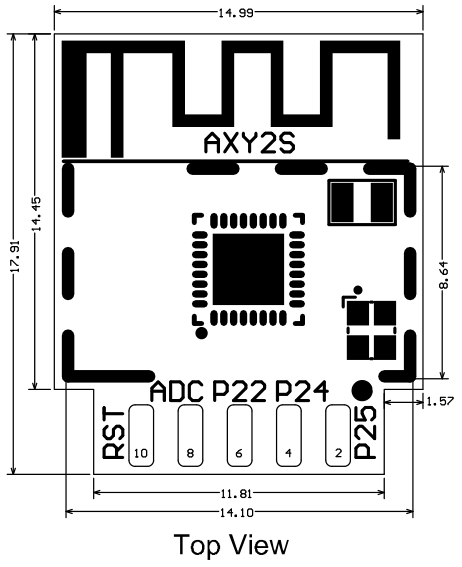
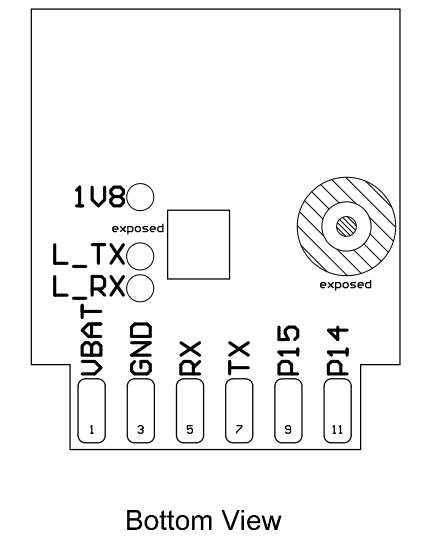
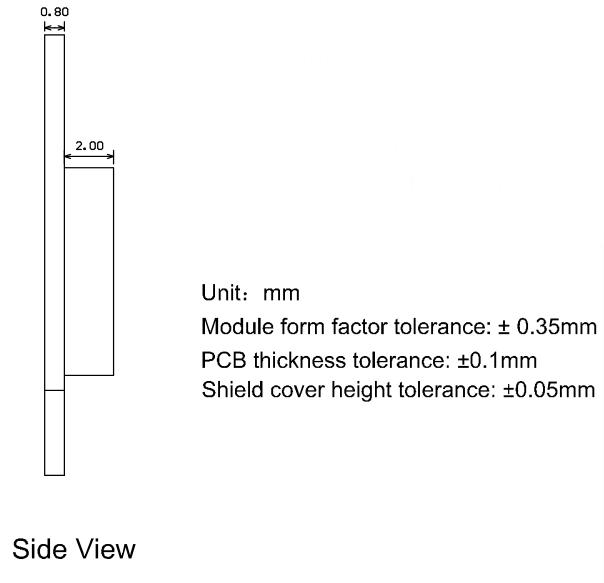
Note: The default dimensional tolerance is ±0.35 mm. If customers have specific requirements on dimensions, they should make them clear in the module datasheet after communication.
Recommended PCB footprint
Schematic diagram of AXY2S which shows how pins correspond:
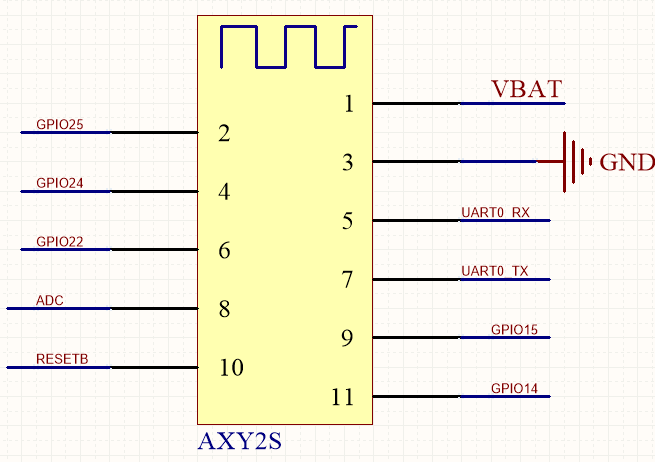
PCB footprint of AXY2S:
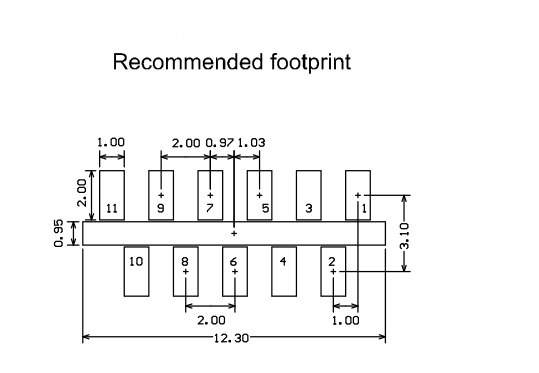
Production instructions
- For the Tuya in-line module, wave soldering is most preferred and manual soldering is less preferred. After being unpacked, the module must be soldered within 24 hours. Otherwise, it must be put into the drying cupboard where the RH is not greater than 10%; or it needs to be packaged under vacuum again and record the exposure time (the total exposure time cannot exceed 168 hours).
- Wave soldering devices and materials:
- Wave soldering equipment
- Wave soldering fixture
- Constant-temperature soldering iron
- Tin bar, tin wire, and flux
- Thermal profiler
- Baking devices:
- Cabinet oven
- Anti-electrostatic and heat-resistant trays
- Anti-electrostatic and heat-resistant gloves
- The module needs to be baked in the following cases:
- The packaging bag is damaged before unpacking.
- There is no humidity indicator card (HIC) in the packaging bag.
- After unpacking, circles of 10% and above on the HIC become pink.
- The total exposure time has lasted for over 168 hours since unpacking.
- More than 12 months have passed since the sealing of the bag.
- Baking settings:
- Temperature: 40°C and ≤ 5% RH for reel package and 125°C and ≤5% RH for tray package (please use the heat-resistant tray rather than plastic container)
- Time: 168 hours for reel package and 12 hours for tray package
- Alarm temperature: 50°C for reel package and 135°C for tray package
- Production-ready temperature after natural cooling: < 36°C
- Re-baking situation: If a module remains unused for over 168 hours after being baked, it needs to be baked again.
-If a batch of modules is not baked within 168 hours, do not use the wave soldering to solder them. Because these modules are Level-3 moisture-sensitive devices, they are very likely to get damp when exposed beyond the allowable time. In this case, if they are soldered at high temperatures, it may result in device failure or poor soldering.
- In the whole production process, take electrostatic discharge (ESD) protective measures.
- To guarantee the quality of products, you must pay attention to the following items: The amount of soldering flux, the height of the wave peak, whether the tin slag and copper content in the wave soldering tank exceed standards, whether the window and thickness of the wave soldering fixture are appropriate, and whether the wave soldering oven temperature curve is appropriate.
Recommended oven temperature curve and temperature
Set oven temperatures according to the following temperature curve of wave soldering. The peak temperature is 260°C±5°C.
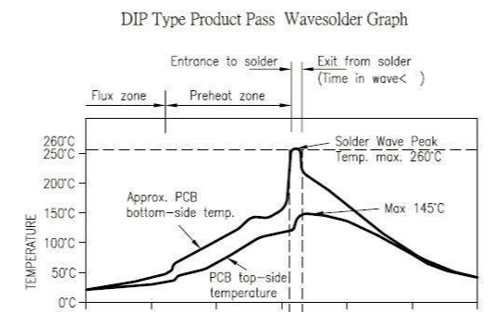
Recommended soldering temperature:
| Suggestions on oven temperature curve of wave soldering | Suggestions on manual soldering temperature | ||
|---|---|---|---|
| Preheat temperature | 80 to 130 °C | Soldering temperature | 360±20°C |
| Preheat time | 75 to 100s | Soldering time | <3s/point |
| Peak contact time | 3 to 5s | NA | NA |
| Temperature of tin cylinder | 260±5°C | NA | NA |
| Ramp-up slope | ≤2°C/s | NA | NA |
| Ramp-down slope | ≤6°C/s | NA | NA |
Storage conditions
Storage conditions for a delivered module:
-
The moisture-proof bag is placed in an environment where the temperature is below 40°C and the relative humidity is lower than 90%.
-
The shelf life of a dry-packaged product is 12 months from the date when the product is packaged and sealed.
-
There is a humidity indicator card (HIC) in the packaging bag.
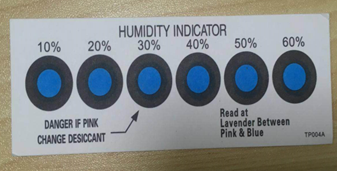
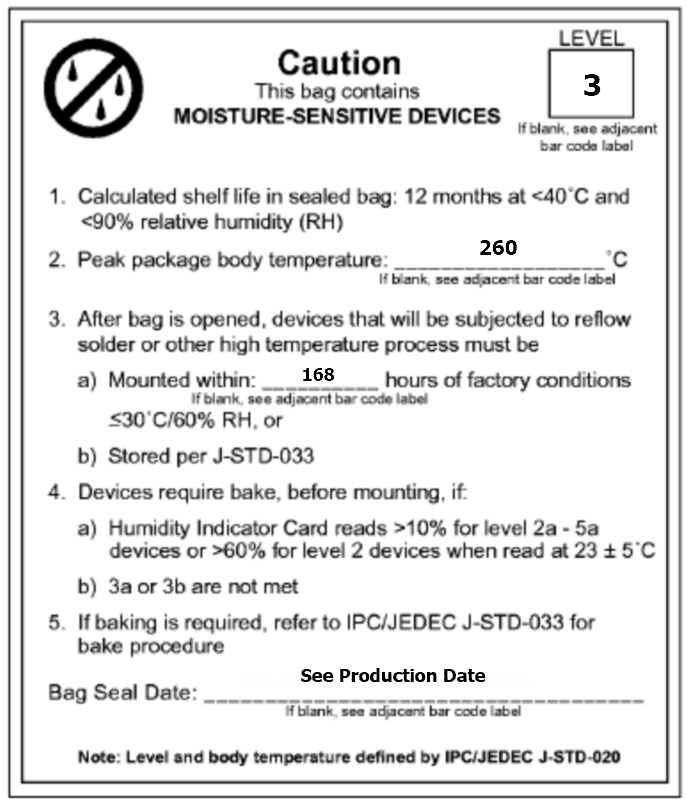
MOQ and packaging information
| Product number | MOQ (pcs) | Shipping packaging method | The number of modules per reel | The number of reels per carton |
|---|---|---|---|---|
| AXY2S | 4400 | Tape reel | 1100 | 4 |
Appendix-Statement
FCC Caution: Any changes or modifications not expressly approved by the party responsible for compliance could void the user’s authority to operate this device.
This device complies with Part 15 of the FCC Rules. Operation is subject to the following two conditions: (1) This device may not cause harmful interference, and (2) this device must accept any interference received, including interference that may cause undesired operation.
Note: This device has been tested and found to comply with the limits for a Class B digital device, according to part 15 of the FCC Rules. These limits are designed to provide reasonable protection against harmful interference in a residential installation. This device generates, uses, and can radiate radio frequency energy and, if not installed and used following the instructions, may cause harmful interference to radio communications. However, there is no guarantee that interference will not occur in a particular installation.
If this device does cause harmful interference to radio or television reception, which can be determined by turning the device off and on, the user is encouraged to try to correct the interference by one or more of the following measures:
- Reorient or relocate the receiving antenna.
- Increase the separation between the device and receiver.
- Connect the device into an outlet on a circuit different from that to which the receiver is connected.
- Consult the dealer or an experienced radio/TV technician for help.
Radiation Exposure Statement
This device complies with FCC radiation exposure limits set forth for an uncontrolled rolled environment. This device should be installed and operated with a minimum distance of 20cm between the radiator and your body.
Important Note
This radio module must not be installed to co-locate and operating simultaneously with other radios in the host system except following FCC multi-transmitter product procedures. Additional testing and device authorization may be required to operate simultaneously with other radios.
The availability of some specific channels and/or operational frequency bands are country-dependent and are firmware programmed at the factory to match the intended destination. The firmware setting is not accessible by the end-user.
The host product manufacturer is responsible for compliance with any other FCC rules that apply to the host not covered by the modular transmitter grant of certification. The final host product still requires Part 15 Subpart B compliance testing with the modular transmitter installed.
The end-user manual shall include all required regulatory information/warnings as shown in this manual, including “This product must be installed and operated with a minimum distance of 20 cm between the radiator and user body”.
This device has got an FCC ID: 2ANDL-AXY2S. The end product must be labeled in a visible area with the following: “Contains Transmitter Module FCC ID: 2ANDL-AXY2S”.
This device is intended only for OEM integrators under the following conditions:
The antenna must be installed such that 20cm is maintained between the antenna and users, and the transmitter module may not be co-located with any other transmitter or antenna.
As long as the 2 conditions above are met, further transmitter tests will not be required. However, the OEM integrator is still responsible for testing their end-product for any additional compliance requirements required with this module installed.
Declaration of Conformity European Notice

Hereby, Hangzhou Tuya Information Technology Co., Ltd declares that this module product is in compliance with essential requirements and other relevant provisions of Directive 2014/53/EU, 2011/65/EU. A copy of the Declaration of conformity can be found at https://www.tuya.com.

This product must not be disposed of as normal household waste, in accordance with the EU directive for waste electrical and electronic equipment (WEEE-2012/19/EU). Instead, it should be disposed of by returning it to the point of sale, or to a municipal recycling collection point.
The device could be used with a separation distance of 20cm to the human body.
Is this page helpful?
YesFeedbackIs this page helpful?
YesFeedback





